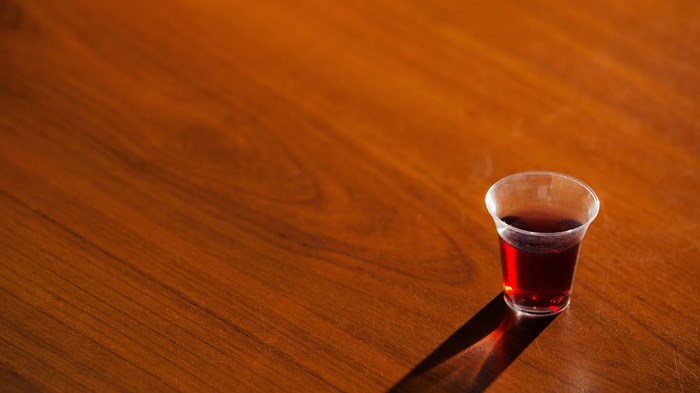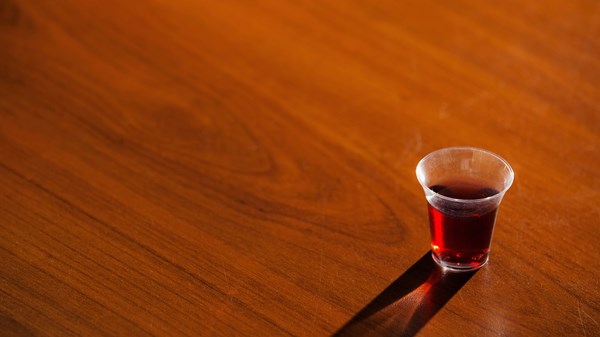
In 1869, a 43-year-old Methodist dentist on his third career helped Methodists change American Protestantism forever. You’ve experienced the results of his change every time you take a drink of Welch’s grape juice. But you wouldn’t be drinking that juice today if it wasn’t for Thomas Bramwell Welch’s desire to make non-alcoholic Communion wine.
T. B. Welch hailed from Glastonbury, England, the place celebrated in British folklore as the gravesite of the legendary King Arthur and his ill-fated queen Guinevere. Born there on December 31, 1825, he came to the United States with his family as a six-year old boy. The Welches settled in upstate New York, where T. B. Welch joined first the Methodist Episcopal Church and then—in anger that these mainstream Methodists permitted slaveholding—their abolitionist offshoot, the Wesleyan Methodists. He began preaching in Wesleyan Methodist churches at age 19, but his vocal chords were no match for his religious fervor, and he was out of the ministry at age 21.
Needing a new occupation to support his wife and children (he had just married the quiet and steady Lucy Hutt, much to the surprise of his parents as she had been serving as the Welches’ cook), T. B. chose medicine, receiving his MD in 1852. But the traveling life of a rural doctor near Syracuse, New York, was not much better for his health than the ministry had been. He turned to dentistry in 1856, moving halfway across the country to Minnesota for 12 years before returning to the East Coast to settle in Vineland, New Jersey in 1869.
T. B. Welch prospered as a dentist for some years. He made false teeth (“good chewers or no sale”) and performed the relatively new operation of extracting teeth “under gas”—nitrous oxide—which had come into common dental use in the 1860s. (Much of the early story of T. B.’s life is told in the excellent corporate history of Welches’ Grape Juice by William Chazanof, Welches’ Grape Juice: From Corporation to Co-operative.)
It’s unknown exactly when during his time in Vineland T. B. returned to the Methodist Episcopal Church (the slaveholding question no longer an issue after the Civil War), but he became active at the First Methodist Episcopal Church there and was asked to serve as a Communion steward. The son of a teetotaling mother and a preacher father who drank occasionally and socially, T. B. had taken his mother’s side in the family arguments and been a teetotaler his whole life. Serving alcoholic wine at Communion bothered him greatly, but no acceptable substitute existed that he knew of. His impetus to develop such a substitute increased, the family story goes, when a visiting preacher with a drinking problem stayed at the Welches’ house and revealed that partaking in Communion wine had awakened dangerous urges.
T.B. and his son Charles—who would one day serve as the marketer of their new discovery to the masses—had heard of Louis Pasteur’s experiments in pasteurizing liquids. Heating the liquids to between 140–212 degrees Fahrenheit killed bacteria and molds, Pasteur had discovered; the yeast naturally occurring on the skin of grapes would be killed. Pasteur injected his pasteurized grape liquid with precisely the kind of yeast he wanted in order to control the flavor of the resulting wine. But T. B. and Charles wanted to halt the process right after the pasteurizing: no yeast, no fermentation. They picked grapes from the trellis outside their house, cooked them, filtered them, and plunged the bottles of cooked and filtered juice into boiling water—keeping them in there not too long, but just long enough.
When the bottles were uncorked, they had not fermented. T. B. had succeeded. Now he had to succeed in selling “Dr. Welch’s Unfermented Wine” to the Methodist church.
Rooted in the Soil of the Temperance Movement
For many years, tellers of the saga of the Welches have believed that the Methodist church was not ready for T. B.’s discovery. After all, Christians had been using wine at the Communion table for over 1,800 years. Methodists were no friends of drunkenness (John Wesley’s tract Word to a Drunkard begins “Are you a man! God made you a man; but you make yourself a beast.”), but they had accepted wine in the sacrament for over 150 years—first as a religious movement within the Church of England and then as a separate denomination. How could their minds have changed so quickly? They must have been convinced by the power of advertising and done it in service to capitalist greed, historians argued.
But the story is more complex than that. And T. B. Welch and his denomination had theological reasons for doing what they did: It was not simply chasing the almighty dollar.
Nineteenth-century Protestant America as a whole was in the middle of a seismic change in the way it viewed alcohol. That tectonic shift would produce the idea of teetotalism: total abstinence from all alcohol. Various people had practiced such abstinence throughout history specifically as an ascetic discipline (from Nazirites in the Bible to Muslim adherents in the Middle East), but asking a whole society to become teetotalers was a new approach to the problem of alcohol abuse, unique to American Protestants and those who came under their influence. The virtue of temperance had been defined ever since Aristotle (in the 4th century BC) as moderation in all things: neither too much nor too little. But by the time the 20th century dawned the average American Protestant understood “temperance” to signify “teetotalism.”
It’s ironic that Americans were on the forefront of the movement for total abstinence, because we started out as a hard-drinking bunch. In the American colonies, whether you were attending a political debate, celebrating Christmas with family and friends, or helping your neighbor put up a barn, there was a good chance you’d all partake liberally in a pint or two (or three or four) of beer or hard cider. If you were a colonial governor or a big landowner, chances were you were putting away a lot of fancy European wine as well. Taverns were the center of social and political life: today’s coffeeshops, post offices, campaign headquarters, and blog networks all rolled into one. Eighteenth-century Americans consumed about 7.1 gallons of absolute alcohol a year on average (that’s about 72 bottles of 100-proof vodka). The bar tab for George Washington’s farewell party by his troops in 1787—a party attended by 55 people—ran to 60 bottles of claret, 54 bottles of Madeira, 22 bottles of porter, 12 bottles of beer, 8 bottles of hard cider, 8 bottles of whiskey, and 7 bowls of spiked punch.
As the 19th century dawned, whiskey rose in popularity (other drinks suffered from Revolutionary-era blockades) and German immigrants brought a new drink, lager beer. And alcohol abuse grew for another reason as well: America was industrializing. In small colonial villages, the whole community could watch out for the local drunk, and tasks were done slowly on small machines or by hand. In the city, you could drink in perfect anonymity—despite the fact that you needed to be sober to operate the newly-invented heavy machinery at your job. Cities also multiplied the number of places where people could buy liquor: bars, groceries, restaurants, beer gardens (blame those Germans). People were drinking more, especially 18- to 25-year-old men, and society had fewer and fewer ways to control them. Perhaps the best way, many like T. B. Welch’s mother thought, was to outlaw alcohol altogether.
The definition of what counted as “alcohol” began to change, too. Early in the 19th century, the focus of temperance agitation was distilled spirits, especially whiskey: a famous “temperance thermometer” produced in the 1780s by Philadelphia physician Benjamin Rush, member of the Continental Congress, attributed the most horrific effects to the consumption of distilled spirits. But cider, strong beer, and wine, if “taken only at meals and in moderate quantities,” would bring “cheerfulness, strength, and nourishment,” said Rush; weak beer along with non-alcoholic drinks would produce “health, wealth, serenity of mind, reputation, long life, and happiness.” (I had confirmed for me that some people still hold to this attitude when I protested to one of my husband’s Scottish second cousins that no, I could not drink the relatively-low ABV Guinness while pregnant. “But it’s practically medicinal!” she said. Indeed, Arthur Guinness had intended his beer as a healthful drink, though that’s another story.)
Such an attitude posed no danger to Communion wine. But by the 1830s–1840s, popular scientific experiments produced new evidence that wine and beer also contained alcoholic stimulants, just in smaller amounts. The most famous of these was US Army surgeon William Beaumont’s experiments on the stomach of a Canadian voyageur named Alexis St. Martin.
St. Martin was injured by a musket in 1822, leaving a hole in his stomach that Beaumont could not fully repair. In 1825, Beaumont began experiments on the human digestion by looking into St. Martin’s stomach. He inserted beef into St. Martin’s stomach on silk strings directly through the hole (removing it when his patient experienced distress), took the stomach’s temperature, observed the changes that weather caused in digestion. And, crucially for the history of alcohol consumption in the United States, he gave St. Martin beer and wine. These, along with pretty much any spicy condiment you can think of (mustard was one chief offender), produced changes in the stomach that led Beaumont to advise against ever consuming them.
The case was a sensation, and Methodist doctor and temperance supporter Thomas Sewall soon got ahold of it, made his own experiments (by dissecting corpses, not looking at live patients), and published the results. Soon, no temperance book was worth its salt if it didn’t have gruesome descriptions of a drunkard’s stomach (here’s one, if you can stand it.) And Communion wine’s days in Methodism were numbered. The Welches weren’t the only temperance-minded individuals trying to find a solution to the problem of alcoholic Communion wine; they were just the first to succeed on a large scale.
A Ripe Vintage for Welch’s New Product
The first article ever questioning the use of alcohol in the Eucharist appeared in 1835, Moses Stuart’s “What Is the Duty of the Churches, in Regard to the Use of Fermented (Alcoholic) Wine, in Celebrating the Lord’s Supper.” Stuart was a Congregationalist scholar and pastor, but his recommendations appeared in the Methodist press. Putting forth extensive scientific and Scriptural evidence, he argued that churches should dilute their wine with water until it was at the non-intoxicating strength that he believed Jesus had consumed.
Stuart’s call to dilute sacramental wine originally puzzled his Methodist editor, Nathan Bangs. But it would not puzzle Methodists, or indeed anybody, for long. His call to support total abstinence in general, and to do something about Communion wine in particular, was taken up by pastors, denominational executives, scholars, and laypeople in all Protestant groups—but especially by the Methodist Episcopal Church. In 1849, Stuart published a pamphlet called Scriptural View of the Wine Question, which popularized what became known as the “two-wine theory”: When the Bible talks about wine in a bad way, it means the fermented stuff, and when the Bible praises wine, it means, well… grape juice. (“Unfermented wine,” its proponents called it.)
But it wasn’t just scholars who took up the cause. Christian laypeople wrote hymns and catechisms in favor of total abstinence, including abstinence at the Communion table. One of the most famous early temperance songbooks was Congregationalist minister John Marsh’s Temperance Hymn Book and Minstrel (1841); one song warned, “Lift not the wine-cup, though pleasure may swim / ’Mid the bubbles that flash round its roseate brim / For dark in the depths of the fountain below / Lurk the sirens that lure to the vortex of woe.” Pastors preached sermons against the making or selling of alcohol. Denominations released a flood of tracts (essentially, the blogs of the 19th century.) From the Methodist Sunday School Union, you could read the tale of “Anthony Todd, the Temperance Boy,” who refused to work for a grocer who sold alcohol; though the evil “rumseller” dismissed him with dire prophecies of starvation, he was hired by a temperance grocer and grew up to be a temperance grocer himself. In droves, churches supported the Maine Law, passed in 1851, which forbade any use or sale of liquor in the state of Maine except for “medicinal, mechanical, or manufacturing purposes;” 12 other states soon followed, and several more had large temperance constituencies which tried very hard to pass such laws but failed. (The Maine Law was repealed in 1856, but prohibition eventually made it into the state constitution in 1885.)
Some church women even published temperance cookbooks, like the 1841 gem Total Abstinence Cookery: Being a Collection of Receipts for Cooking, From Which All Intoxicating Liquids Are Excluded. And even as T. B. and Charles Welch were growing their grapes and plunging them into hot water, British Christian scholar Frederic Lees was preparing the manuscript of his magisterial Temperance Bible Commentary (1870). This work looked at every single place in the Old Testament and New Testament where alcohol was mentioned and divided them up into condemnations of the fermented kind and commendations of the unfermented kind. Its scholarly conclusions sometimes appeared tortured, but its erudition was unmistakable, and it was a temperance publishing sensation on both sides of the Atlantic. Nearly every Protestant teetotaler argued their cause from the pages of “Dr. Lees” from then on.
The Effects of Alcohol Non-Consumption
The motives of temperance reformers, including the Welches, have frequently been mocked by later writers. From the contemporary standpoint of knowing that national prohibition in the 20th century failed—and failed miserably, at that—temperance reformers have been called all sorts of legalists, killjoys, and Puritans. Alcohol shouldn’t be marginalized, thought the elites and the business owners of a post-Prohibition world; it should be marketed. (This book argues that there was almost a conspiracy in the 1920s and 1930s to normalize and market to the unsuspecting masses the “minor vices” like drinking, smoking, and swearing. It’s hard for me to believe he’s wrong.)
In the process, we’ve lost a window into the lives of many 19th-century Christians who were trying to solve problems of broken homes, unemployment, abused and neglected women, predatory lending, and crime. Methodist pastor, president of Northwestern University, and eventually bishop Charles Fowler commented in a popular tract that if Jesus supported alcohol, he supported “wife-beating and child-beating” and “seven-eighths of all the crimes committed in the civilized world.” Temperance advocates sincerely believed that eliminating all alcohol would solve all of these problems. It was one reason support for temperance was often entwined with support for women’s suffrage: If women could vote, the argument ran, they would vote against the liquor traffic.
Why couldn’t temperance advocates simply advocate for moderate drinking? They thought it set too bad an example, for one thing. In the same vein as D. L. Mayfield’s recent article in Christianity Today, Fowler made arguments including that the poor would follow, with disastrous results.
They also thought that God had designed minds, and Christians ought to be careful about how we use them. Beneath nearly all the assumptions of 19th-century Protestantism ran a system of thought called “common-sense realism,” which said the human mind was made to take data in from the senses and use that data to produce outputs in the form of moral judgement and behaviors. But what if alcohol (or cigarettes or sexy novels or…) blurred what your senses perceived? In the words of computer programmers from a century later: “Garbage in, garbage out.” Put good things in, and you would behave as a good Christian and a good citizen. Put bad things in, and you would lose your job, beat your children, and fail to follow God.
And their efforts worked, at least as far as absolute consumption of alcohol was concerned—a fact that neither the 19th-century temperance advocates nor their later detractors ever really grasped. Remember those hordes of Americans drinking seven gallons a year of absolute alcohol in 1830? By 1835 that number was five, by 1840 it was three, and by 1848 it was one gallon. The number began climbing upwards in the 20th century, but it only made it to three gallons right before Prohibition, and at the end of the 20th century it was just a little under a gallon (that’s down to ten bottles of 100-proof vodka per person per year). Even though modern society seems to drink a lot, we actually have nothing on our colonial ancestors. The temperance movement is one reason for that.
Unfermented Wine for Sacramental Occasions
It was into a temperance world that T. B. Welch attempted to release his new unfermented Communion wine. He was good at experimenting, but he wasn’t good at marketing, and in 1873 he gave up the endeavor. But Charles Welch, just as successful a dentist as his father, was a much better salesman. While practicing in Washington, DC, the enterprising 23-year-old—described by family members as jovial and fun-loving, yet also single-mindedly determined when it suited him—visited his father in New Jersey in 1875 and convinced T. B. to start again making his non-fermented grape juice again.
Others were already selling grape juice. They were even selling it in New Jersey. The 1874 Journal (annual minutes) of the Newark Conference of the Methodist Episcopal Church, for example, contains an ad for “Speer's Port Grape Wine and Unfermented Juice of the Oporto Grape Made Expressly for the Communion Table.” Surely, there was a market for the Welch version.
Indeed, Methodists had been looking for grape juice at the table since midcentury. In 1864, Methodist legislators recommended “earnestly...that in all cases the pure juice of the grape be used in the celebration of the Lord’s Supper” and by 1872 the recommendation was for “the use of unfermented wine on our sacramental occasions.” In 1876 they put their recommendations into the Methodist Communion liturgy and by 1880 it was a requirement, not just a recommendation.
Meanwhile, Charles had moved back to Vineland and combined grape-juice peddling and dentistry. (He actually met his first wife, Jennie Ross, because she was a grape-juice customer.) He began placing ads, among other places, in Methodist church publications and annual minutes, advertising “the pure, unfermented, undiluted juice of the choicest Concord Grape” for either the dinner table or the Communion table, since “Welch’s Grape Juice is so properly the fruit of the vine, that consumers using it are delighted.” He even created his own newspapers, The Acorn and The Progress, to sell the juice.
In 1882, Charles incorporated as C. E. Welch and Co., and in 1893 he abandoned his dental practice completely, turning it over to his sister Emma Welch Slade—who was also a dentist, as was her husband, Sam. He briefly entertained the idea of going to Africa as a missionary for the Methodist church, but finally decided (under firm pressure from his wife and his mother) that he could do more for the cause by staying home and supporting temperance at home and abroad through charitable donations from the profits from his production of grape juice.
Exhibiting at the World’s Fair in Chicago in 1893 brought Welch’s endeavors to prominence, and prompted Charles to seek out better grapes: first in Watkins, New York, and then in Westfield, the company’s home for the next nine decades. He incorporated the Welch Grape Juice Company in 1897. It ironically became a victim of Prohibition for a while (when the public sale and manufacture of alcohol was outlawed by the Eighteenth Amendment, everyone suddenly wanted grapes to make their own wine in their houses), but it survived and still counts many churches among its customers.
In 1916, Methodists made the use of grape juice mandatory, and what Methodists did, many of their Protestant cousins did also. You’ll find fermented Communion wine in Catholic, Anglican, and Lutheran churches today, but pretty much nowhere else in the US, despite the efforts of numerous scholars and worship planners over the last 40 years or so to reclaim the older Christian practice.
Charles Welch died in 1926 at age 74, a successful businessman and philanthropist. In his will, besides the usual family and charitable bequests, the executors found this sentence: “Unfermented grape juice was born in 1869 out of a passion to serve God by helping his church to give at its Communion ‘the fruit of the vine’ instead of ‘the cup of devils.’”
Jennifer Woodruff Tait is the managing editor of Christian History and the author of The Poisoned Chalice: Eucharistic Grape Juice and Common-Sense Realism in Victorian Methodism. She also works for The High Calling and is an Episcopal priest.

Support Our Work
Subscribe to CT for less than $4.25/month





























